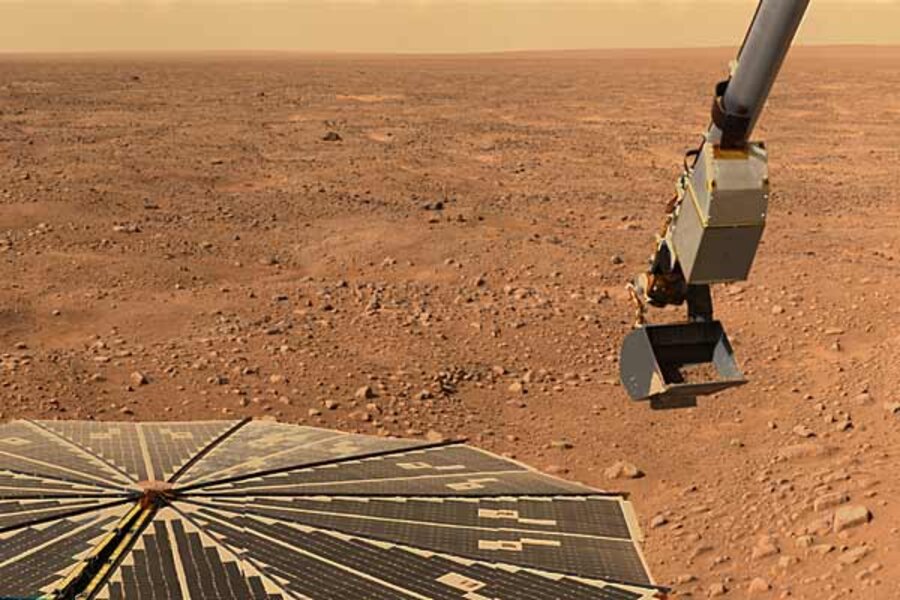Mars a 'dead' planet? Its water history may suggest otherwise.
Loading...
If new results from the now defunct Mars Phoenix mission are any indication, the planet is not dead yet.
Data from the Mars Phoenix lander indicate that liquid water has been weathering the planet's surface throughout its history, even into recent geological times. The data also suggest that geologically recent volcanic eruptions have replenished the planet's carbon-dioxide atmosphere in what could be an ongoing activity.
The evidence comes in the form of intricate measurements the lander took of the planet's atmosphere – specifically, the relative abundance of different forms of carbon and oxygen in atmospheric CO2.
The results add to an emerging, large-scale picture of Mars as a more dynamic planet than previously thought, according to Paul Niles, a researcher at NASA's Johnson Space Center in Houston. Dr. Niles led the team reporting its results in this week's issue of the journal Science.
The atmospheric measurements represent "a critical piece of data that people have been waiting for," he says, adding that the data also "reveal some new things about the puzzle" that Mars presents.
Mars Phoenix's hints of dynamic interplays involving water, surface rocks, and the atmosphere over time contrast sharply with the once-prevailing view that the red planet was a dead planet. Mars started out with a large, thick carbon-dioxide atmosphere after its birth some 4.6 billion years ago. The planet's weak gravity and lack of a magnetic field allowed much of that initial atmosphere to escape into space, however, leaving only a dwindling remnant behind.
The other possibility, Niles says, is that while Mars lost a fair portion of that initial atmosphere to space, carbon also was captured to form carbon-bearing minerals on the planet's surface – a process that requires the presence of liquid water. Over time, CO2 emitted through periodic volcanism offset to some degree the CO2 lost through these other processes.
"It seems like that second possibility is really what's going on," he says.
The picture came together as the team analyzed the relative abundance of two isotopes of carbon and two of oxygen in the Martian atmosphere. They compared them with carbon and oxygen isotopes locked up in carbon and oxygen found in Martian meteorites found on Earth. The meteorites – cosmic time capsules bearing evidence of the conditions on Mars at the time they formed – ranged in age from about 4.3 billion years old to 150 million years old.
Indeed, carbon-isotope measurements from the earliest meteorite sample testified to a thicker atmosphere at the time – one much richer in the lighter of the two isotopes of carbon the team examined. That lighter form eventually would rise to the top of the atmosphere to become lost in space.
And while Mars' atmosphere has thinned, the carbon-isotope signature in the 150-million-year-old meteorite perfectly matched that from atmospheric samples Mars Phoenix measured in 2008.
Moreover, the carbon signature, Niles says, "is more similar to what you'd see coming out of volcanoes."
If the atmosphere had been constantly stripped over time, with no replenishment, "the remnant carbon would have a much different isotopic signature than the one we measured," he adds.
Once the team saw the volcanic signature in carbon, it turned its attention to oxygen, a vital component of water. In this case, the ratio of light to heavy oxygen isotopes the team found in Mars' atmospheric CO2 failed to match the signature carried by oxygen in volcanic CO2. Instead, the signature closely matched that of oxygen in CO2 that has been cycled through liquid water.
Indeed, the presence of that oxygen signature in the atmosphere and in the 150-million-year-old meteorite shows "that we're forming carbonates on Mars even under the kind of conditions we see on the surface" today.
A similar signature appears in the oldest meteorite as well, implying that the formation of carbonates on Mars could have been largely a cold-water activity, as opposed to requiring water heated by hydrothermal activity.
The Mars Phoenix results join other evidence that the planet is not yet geologically comatose.
Recent observations from spacecraft orbiting Mars have uncovered evidence of 100-million-year-old lava flows on the surface – just yesterday in a 4.6 billion-year history. In addition, the orbiters have detected evidence of fresh flows – appearing during the course of the orbiters' missions – that carve gullies down the sides of Martian craters. One explanation for the flows holds that water ice just below the surface melted suddenly at a weak spot in the crater walls, burst out, and flowed down the slope before it quickly evaporated.
All in all, if the Mars Phoenix results hold up, they will add to a growing body of evidence that planetary scientists are no longer looking at their fathers' Mars.





